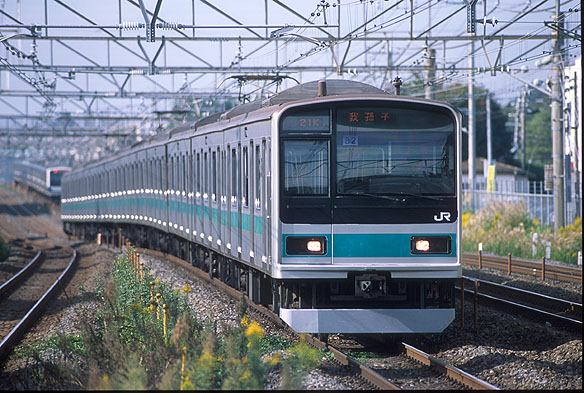Background and overview
JR East developed commuter DC electric multiple unit (EMU) for additional
capacity of Johban line and Teito Rapid Transit Authority's (the present
Tokyo Metro) Chiyoda line interrunning services in 1999. Two 10-car sets
consisting of 6 powered vehicles and 4 trailer vehicles to get acceleration
performance of 3.3km/h/s to fit the agreement with Teito Rapid Transit
Authority were delivered in 1999.
Car body
They have 2800mm wide body to fit the loading gauge of Chiyoda line, incorporating
unpainted bead-less light weight stainless construction. They are constructed
with the outside sheets and inner beams as usual with introducing some
improvements. In addition, although the body length of 209-0 series' end
vehicles is 420mm longer than those of intermediate vehicles, the body
length of all vehicles of 209-1000 series is standardized into 19500mm
to fit the agreement with Teito Rapid Transit Authority. They have emerald
green coloured waistline and headline bands running the length of each
car below and above the windows. Cab ends have an emergency gangway employing
swing plug door construction on the left side of the front. Cab ends are
covered with a Fiber Reinforced Plastics (FRP) painted in silver. Anti-fall
plates between vehicles are also introduced excepting the cab end. They
are equipped with four 1300mm wide double-leaf automatic sliding doors,
two drop windows between the doors excepting centre of the vehicles, and
three fixed windows at the end and the centre on each side of the vehicle.
The distance between the 1st and the 2nd doors from the frond of end vehicles
is narrower than the others caused by shortening end vehicle's body length.
Door operating equipments, TKE150, featuring electric screw drive are fitted
above the door header of the sliding doors. LED destination displays are
fitted on the side of their body. An air conditioner, AU720A, rated at
42,000kcal/h, is fitted on the centre of their roof. No ventilators are
fitted on the roof.
Bogies
The 209-1000 series are equipped with DT61D bogies on the powered vehicles
and TR246L bogies on the trailers, featuring bolster-less secondary air
suspension, trailing arm link journal box supporting system, and the single
link traction device. The air suspension's effective diameter of 209-0
series is 560mm. However, that of 209-1000 series is reduced to 500mm.
These bogies be prepared to adopt the yaw dampers to ensure smooth ride
characteristics. Twin Disc (TD) flexible joint employing deflecting plates
made of carbon-fiber reinforced plastic (CFRP) is applied for power transmission
device. Their brake rigging is a single tread brake for powered and both
directly the single disk and the single tread brake for trailer.
Traction unit and ancillary equipments
Class moha209-1000 vehicles are equipped with 3-step Variable-frequency drive (VFD) traction system, SC41D, which controls 8 traction motors, MT73, with a power output of 95kW on vehicle basis including class moha208-1000 vehicles. This traction system features modular-unit low withstand voltage Gate Turn Off (GTO) thyristor. Class moha208-1000 powered intermediate vehicles are equipped with an auxiliary power unit, SC37B with a power output of 210kVA featuring GTO thyristor under their floor. Class moha209-1000 powered intermediate vehicles are equipped with a standard diamond-shaped current pickup, PS21, on their roof. Class moha208-1000 powered intermediate vehicles are equipped with a motor driven screw air compressor, MH3112-C1600SL under their floor. 209-1000 series employ the electric commanding brake with regenerative brake, featuring brake control of trailer priority.
Accommodation
Passenger accommodation consists of longitudinal bench seating featuring cantilever construction throughout, with an individual seat width of 450 mm per person. Handrails are fitted at the both end and middle of seats. The cushion of seating is made of polyester resin mold with taking recyclability. Car's No. 2 and 9 are equipped with a wheelchair/stroller space to match Teito Rapid Transit Authority's vehicles.
Operations
They entered commuter revenue services of Joban and Chiyoda lines in December, 1999. However, 209-1000 series train sets were displaced with E233-2000 series and relocated to Chuo line rapid services in 2018. Now, 209-1000 series are used on the rapid services of Chuo lines. |
|

